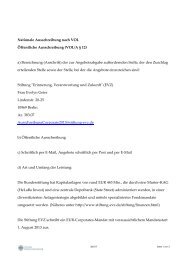chapter 2 - Stiftung "Erinnerung, Verantwortung und Zukunft"
chapter 2 - Stiftung "Erinnerung, Verantwortung und Zukunft"
chapter 2 - Stiftung "Erinnerung, Verantwortung und Zukunft"
Create successful ePaper yourself
Turn your PDF publications into a flip-book with our unique Google optimized e-Paper software.
Aidan McQuade<br />
hoods, impoverishment, social disruption, and lawlessness which result from widespread violence. Under<br />
these conditions, ordinary people become vulnerable to exploitation for profit. The Balkan conflict of the<br />
1990s facilitated widespread exploitation and trafficking, particularly of women and girls who were forced<br />
into sexual exploitation. These atrocities are not unique. The Angolan conflict also fostered this form of trafficking<br />
and exploitation, as does the conflict in Uganda today.<br />
Descent-Based Slavery<br />
Most people associate the word “slavery” with traditional forms of chattel or ownership slavery. This form<br />
of slavery also exists today, most notably in West Africa, where children are born into slavery by inheriting<br />
their status from their mother. In this way, slavery is passed down through the generations. Anti-Slavery International<br />
describes this form of slavery as descent-based slavery. People enslaved in this way are attached to<br />
a master’s family; they are their master’s property and wholly <strong>und</strong>er their master’s control, forced to perform<br />
unpaid domestic and agricultural work.<br />
One example of this form of decent-based slavery is the case of Hadijatou Mani. Mani was born into an established<br />
slave class. Like all slaves in Niger, her slave status was inherited. She was forced to work without<br />
pay, and was also used as a sexual slave by her master. In October 2008, the Community Court of Justice of<br />
the Economic Community of West African States (ECOWAS) fo<strong>und</strong> the Republic of Niger guilty of failing to<br />
protect twenty-four-year-old Mani, a citizen of Niger, from this form of slavery. After the verdict, Hadijatou<br />
Mani said, “We are all equal and deserve to be treated the same. I hope that everybody in slavery today can find<br />
their freedom. No woman should suffer the way I did.” 9 Yet six years after Niger formally criminalized slavery,<br />
at least 43,000 people remained enslaved across the country. Although largely ignored by the rest of the world,<br />
decent-based slavery continues to affect thousands of people across West Africa today.<br />
The Evolution of Slavery in History<br />
The ILO has established six indicators to identify forced labor. According to the ILO criteria, forced labor may<br />
exist <strong>und</strong>er conditions of threat or actual physical harm to the worker; restriction of movement and confinement<br />
to the workplace or to a limited area; debt bondage, including when the employer provides food and lodging at<br />
such inflated prices that the worker cannot escape the debt; withholding of wages or excessive wage reductions<br />
that violate prior agreements; retention of passports and identity documents to prevent escape, or to prevent<br />
the worker from confirming his or her identity or status; and threat of denunciation to the authorities when the<br />
worker has an irregular immigration status.<br />
At Anti-Slavery International, we argue that any one of these indicators is suggestive of forced labor. When<br />
two or more indicators exist, we consider the worker a forced laborer. The ability to identify working conditions<br />
as forced labor is crucial, particularly because the history of slavery shows that sustained abolition campaigns<br />
often cause slavery to mutate in form. As new slavery practices emerge, we need to be able to assess<br />
them against a consistent standard.<br />
The mutability and durability of slavery as an institution is amply demonstrated by the history of its development<br />
across the centuries. In the late 18 th century, British abolitionists believed that ending the Atlantic slave<br />
trade would spell the end of slavery as an institution. This proved a mistaken hope, although the abolition<br />
campaigns may have improved the lives of people in slavery because slave holders fo<strong>und</strong> it more difficult to<br />
replace slaves they had tortured and worked to death. However, the campaign to end the Atlantic slave trade<br />
9 The verdict is reprinted in http://www.unhcr.org/refworld/publisher,ECOWAS_CCJ,,,496b41fa2,0.html, accessed Nov. 3, 2009.<br />
118<br />
<strong>Stiftung</strong> EVZ<br />
HUMAN RIGHTS AND HISTORY: A CHALLENGE FOR EDUCATION

















